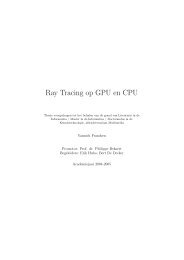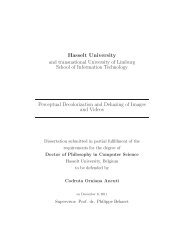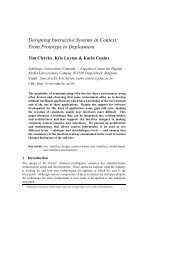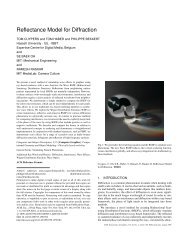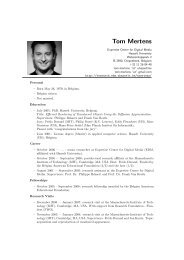DOCTORAATSPROEFSCHRIFT - EDM - UHasselt
DOCTORAATSPROEFSCHRIFT - EDM - UHasselt
DOCTORAATSPROEFSCHRIFT - EDM - UHasselt
You also want an ePaper? Increase the reach of your titles
YUMPU automatically turns print PDFs into web optimized ePapers that Google loves.
2 General Introduction<br />
have boosted computer graphics and animation research, resulting in excellent<br />
real-time graphical rendering of virtual worlds with animated creatures and<br />
physically simulated objects. Auditory feedback has also been investigated<br />
thoroughly, and many contemporary applications support realistic sound effects<br />
and 3D localized sound. On the other hand, olfactory and taste feedback<br />
have gained very little attention from the VR research community and although<br />
some experimental systems exist [Davide 01, Chen 06], these domains<br />
are considered to be in their early research phase. As processing power increased<br />
over the last years, haptic feedback, stimulating the sense of touch,<br />
has gained more and more interest and has grown into a mature domain. As a<br />
result, it has been successfully applied in several practical applications in the<br />
domains of robotics, telerobotics, CAD, sculpting, medical simulations and<br />
training [Stone 00], and several kinds of haptic Input/Output (IO) devices<br />
have been developed [Berkley 03, Fisch 03].<br />
Not only computer interface technology has advanced. The advances in<br />
communication technologies have caused geographical boundaries for social<br />
interaction to be practically dissolved. The use of asynchronous information<br />
exchange systems such as the WWW and email have become omnipresent<br />
and fulfill a key role in the current workspace. The expansion of high-speed<br />
broadband Internet access, has led to the rising of synchronous communication<br />
systems such as applications for real-time communication, videoconferencing<br />
and distributed forms of VR, often referred to as Networked Virtual Environments<br />
(NVEs) or Collaborative Virtual Environments (CVEs). However, the<br />
deployment of these systems has been much less preeminent.<br />
Thus, the technology to enable realistic NVEs has advanced enormously,<br />
and the research done resulted in several standards allowing the creation and<br />
distribution of different kinds of data necessary to support such environments.<br />
Furthermore, several VR applications are successfully being used in several<br />
fields such as surgery training, flight simulators, networked shared environments<br />
for teleconferencing, human factors analysis, training, education, virtual<br />
prototyping, simulation-based design and entertainment and many more.<br />
The increasing power of contemporary computers combined with the lowering<br />
of hardware and connectivity costs permits people to have all this technology<br />
available in their homes and workplaces. So why is it that we are still working<br />
on 2D desktops? Why are we still sending emails typed on a keyboard? And<br />
how come the only widely known applications of VR are the commercial computer<br />
games? Why don’t we make use of all the technology that is available<br />
at our fingertips?



